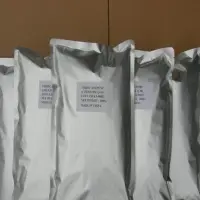-
Categories
-
Pharmaceutical Intermediates
-
Active Pharmaceutical Ingredients
-
Food Additives
- Industrial Coatings
- Agrochemicals
- Dyes and Pigments
- Surfactant
- Flavors and Fragrances
- Chemical Reagents
- Catalyst and Auxiliary
- Natural Products
- Inorganic Chemistry
-
Organic Chemistry
-
Biochemical Engineering
- Analytical Chemistry
- Cosmetic Ingredient
-
Pharmaceutical Intermediates
Promotion
ECHEMI Mall
Wholesale
Weekly Price
Exhibition
News
-
Trade Service
Promoting the enrichment and penetration of drugs in tumor sites is an important means to improve the effect of anti-tumor treatment.
Recently, the State Key Laboratory of Biochemical Engineering of the Institute of Process Engineering of the Chinese Academy of Sciences and the School of Chemical Science of the University of Chinese Academy of Sciences have cooperated to load photothermal nanoparticles and immunoagonists in platelets to prepare a new type of platelet biomimetic dosage form.
Enrichment and penetration of deep tumor tissues realizes efficient tumor photothermal-immune combined therapy, significantly inhibits tumor progression in a variety of animal models, and brings new ideas for targeted tumor delivery and combined therapy.
Related research results were published on Science Advances.
In recent years, photothermal therapy has received more and more attention due to the advantages of precise and controllable treatment sites, high killing efficiency and low side effects.
At present, research has developed a variety of carriers, which are expected to deliver photosensitizers to tumor sites.
However, due to tumor heterogeneity and individual differences, the enrichment effect needs to be improved.
Tumor tissue has dense extracellular matrix and high interstitial osmotic pressure, which further limits the penetration of the carrier into the tumor.
In addition, small lesions remaining on the edge of the tumor site after treatment can easily cause tumor metastasis and recurrence.
Platelets naturally adhere to damaged blood vessels and can form thrombi and secrete nanovesicles in an activated state.
Inspired by this, combined with the research experience of vaccine adjuvants and tumor immunity, researcher of the Bioformulation and Biomaterials Team of the State Key Laboratory of Biochemical Engineering Ma Guanghui and Wei Weiyan proposed a new strategy for the use of platelet biomimetic formulations in the combined treatment of tumors with photothermal-immune therapy, and conducted collaborative research with Professor Tian Zhiyuan of the National University of Science and Technology.
The research introduces polymer nanoparticles and immunoagonists with high light-to-heat conversion efficiency into platelets gently and efficiently, and uses the natural properties of platelets to selectively adhere to defective tumor blood vessels in the body.
Under low-power near-infrared light irradiation, the local acute vascular damage of the tumor caused by photothermal can activate the adherent platelets, and form thrombi in the tumor blood vessels through the cascade effect, thereby forming photothermal nanoparticles and immune agonists.
Ammunition Depot".
The enriched platelets can further secrete nano-scale platelet vesicles under the above-mentioned activated state, and transport the photothermal nanoparticles and immunoagonists to the depths of tumor tissues.
This is conducive to photothermal removal of more tumor cells, and can enhance the immunogenicity of tumor antigens, and completely inhibit tumor metastasis and recurrence in animal experiments.
The loaded nanoparticles, drugs, etc.
have good flexibility, and platelets can be obtained from patients or donors, so the platelet biomimetic dosage form has a good clinical application prospect in the field of individualized and precise treatment of tumors.
The above results have completed the construction of humanized platelet formulations, and confirmed significant efficacy in patient-derived tumor xenograft models that reconstruct the humanized immune system.
Preclinical studies at the animal level have yet to confirm the actual clinical efficacy.
The Biochemical Laboratory of the Institute of Process Engineering has discovered and created a series of new anti-tumor delivery formulations, which are used in the treatment of breast cancer, melanoma, lymphoma and other malignant tumors in animal models, and some of the formulations have been ethically approved to enter preclinical and clinical trials.
the study. Related work has been published in Nature Materials 2018, 17, 187, Nature Biomedical Engineering 2020, s41551-020-00624-6, Science Advances 2020, 6, eaay7735, Science Advances 2019, 5, eaaw3192, Nature Communications 2017, 8, 14537, Nature Communications 2019, 10, 5165, Advanced Materials 2020, 32, 2002085, Advanced Materials 2020, 32, 2002940, Advanced Science 2020, 7, 2001108, etc.
Doctor Lv Yanlin from the Biochemical Laboratory and PhD student Li Feng are the co-first authors of the paper, and Ma Guanghui, Wei Wei and Tian Zhiyuan are the co-corresponding authors of the paper.
The research work is supported by the National Natural Science Foundation of China General Program, Innovative Research Group Program, Youth Fund Program, National Key R&D Program and the Chinese Academy of Sciences Strategic Leading Science and Technology Program.
Figure 1.
Schematic diagram of the effect of platelet-based biomimetic formulations in tumor photothermal-immune combined therapy Figure 2.
The efficacy of human-derived platelet-based bionic formulations in a patient-derived breast cancer xenograft model that reconstructs the humanized immune system: ( a) Model construction and treatment strategies; (b) Super-resolution fluorescence imaging of human-derived platelet biomimetic dosage forms; (c) Flow cytometry to characterize the aggregation ability of human-derived platelet biomimetic dosage forms; (d, e) Photothermal induction of human platelets The accumulation of biomimetic formulations at the tumor site; (f) Frozen section of tumor tissue, showing CD8+ T cell infiltration; (g, h) mouse tumor growth curve and survival curve.
Source: Institute of Process Engineering, Chinese Academy of Sciences
Recently, the State Key Laboratory of Biochemical Engineering of the Institute of Process Engineering of the Chinese Academy of Sciences and the School of Chemical Science of the University of Chinese Academy of Sciences have cooperated to load photothermal nanoparticles and immunoagonists in platelets to prepare a new type of platelet biomimetic dosage form.
Enrichment and penetration of deep tumor tissues realizes efficient tumor photothermal-immune combined therapy, significantly inhibits tumor progression in a variety of animal models, and brings new ideas for targeted tumor delivery and combined therapy.
Related research results were published on Science Advances.
In recent years, photothermal therapy has received more and more attention due to the advantages of precise and controllable treatment sites, high killing efficiency and low side effects.
At present, research has developed a variety of carriers, which are expected to deliver photosensitizers to tumor sites.
However, due to tumor heterogeneity and individual differences, the enrichment effect needs to be improved.
Tumor tissue has dense extracellular matrix and high interstitial osmotic pressure, which further limits the penetration of the carrier into the tumor.
In addition, small lesions remaining on the edge of the tumor site after treatment can easily cause tumor metastasis and recurrence.
Platelets naturally adhere to damaged blood vessels and can form thrombi and secrete nanovesicles in an activated state.
Inspired by this, combined with the research experience of vaccine adjuvants and tumor immunity, researcher of the Bioformulation and Biomaterials Team of the State Key Laboratory of Biochemical Engineering Ma Guanghui and Wei Weiyan proposed a new strategy for the use of platelet biomimetic formulations in the combined treatment of tumors with photothermal-immune therapy, and conducted collaborative research with Professor Tian Zhiyuan of the National University of Science and Technology.
The research introduces polymer nanoparticles and immunoagonists with high light-to-heat conversion efficiency into platelets gently and efficiently, and uses the natural properties of platelets to selectively adhere to defective tumor blood vessels in the body.
Under low-power near-infrared light irradiation, the local acute vascular damage of the tumor caused by photothermal can activate the adherent platelets, and form thrombi in the tumor blood vessels through the cascade effect, thereby forming photothermal nanoparticles and immune agonists.
Ammunition Depot".
The enriched platelets can further secrete nano-scale platelet vesicles under the above-mentioned activated state, and transport the photothermal nanoparticles and immunoagonists to the depths of tumor tissues.
This is conducive to photothermal removal of more tumor cells, and can enhance the immunogenicity of tumor antigens, and completely inhibit tumor metastasis and recurrence in animal experiments.
The loaded nanoparticles, drugs, etc.
have good flexibility, and platelets can be obtained from patients or donors, so the platelet biomimetic dosage form has a good clinical application prospect in the field of individualized and precise treatment of tumors.
The above results have completed the construction of humanized platelet formulations, and confirmed significant efficacy in patient-derived tumor xenograft models that reconstruct the humanized immune system.
Preclinical studies at the animal level have yet to confirm the actual clinical efficacy.
The Biochemical Laboratory of the Institute of Process Engineering has discovered and created a series of new anti-tumor delivery formulations, which are used in the treatment of breast cancer, melanoma, lymphoma and other malignant tumors in animal models, and some of the formulations have been ethically approved to enter preclinical and clinical trials.
the study. Related work has been published in Nature Materials 2018, 17, 187, Nature Biomedical Engineering 2020, s41551-020-00624-6, Science Advances 2020, 6, eaay7735, Science Advances 2019, 5, eaaw3192, Nature Communications 2017, 8, 14537, Nature Communications 2019, 10, 5165, Advanced Materials 2020, 32, 2002085, Advanced Materials 2020, 32, 2002940, Advanced Science 2020, 7, 2001108, etc.
Doctor Lv Yanlin from the Biochemical Laboratory and PhD student Li Feng are the co-first authors of the paper, and Ma Guanghui, Wei Wei and Tian Zhiyuan are the co-corresponding authors of the paper.
The research work is supported by the National Natural Science Foundation of China General Program, Innovative Research Group Program, Youth Fund Program, National Key R&D Program and the Chinese Academy of Sciences Strategic Leading Science and Technology Program.
Figure 1.
Schematic diagram of the effect of platelet-based biomimetic formulations in tumor photothermal-immune combined therapy Figure 2.
The efficacy of human-derived platelet-based bionic formulations in a patient-derived breast cancer xenograft model that reconstructs the humanized immune system: ( a) Model construction and treatment strategies; (b) Super-resolution fluorescence imaging of human-derived platelet biomimetic dosage forms; (c) Flow cytometry to characterize the aggregation ability of human-derived platelet biomimetic dosage forms; (d, e) Photothermal induction of human platelets The accumulation of biomimetic formulations at the tumor site; (f) Frozen section of tumor tissue, showing CD8+ T cell infiltration; (g, h) mouse tumor growth curve and survival curve.
Source: Institute of Process Engineering, Chinese Academy of Sciences







